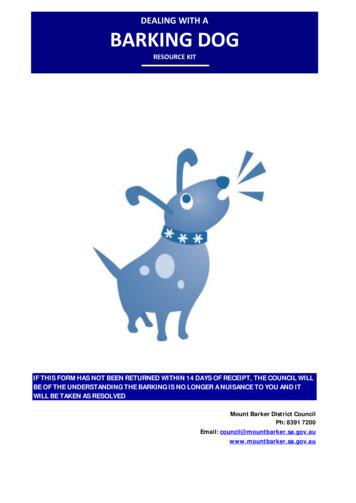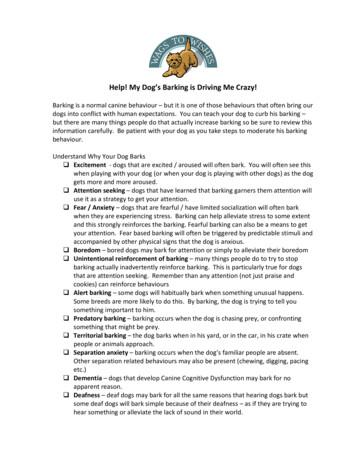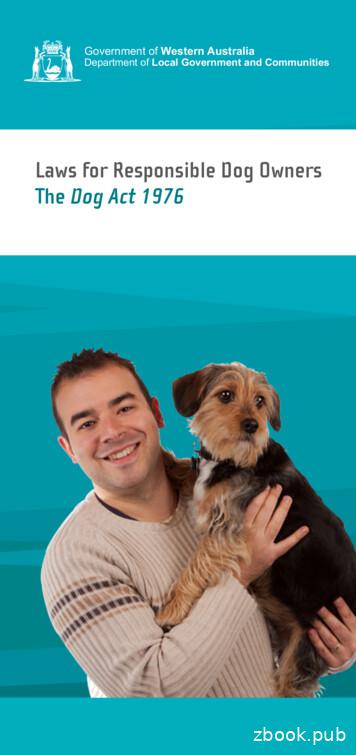DEALING WITH A BARKING DOG - Mount Barker District Council
DEALING WITH ABARKING DOGRESOURCE KITIF THIS FORM HAS NOT BEEN RETURNED WITHIN 14 DAYS OF RECEIPT, THE COUNCIL WILLBE OF THE UNDERSTANDING THE BARKING IS NO LONGER A NUISANCE TO YOU AND ITWILL BE TAKEN AS RESOLVEDMount Barker District CouncilPh: 8391 7200Email: v.au
ContentsIntroductionWhy dogs barkNeighbourhood communicationYour legal requirements for court actionsLodging a complaint with CouncilCouncil ActionBarking dog complaint formDear Neighbour letterSome simple tips for reducing barking
IntroductionDogs are an important part of our local community, but dogs that barkexcessively can become a source of irritation for neighbours and others usingthe local environment. Our best friend can, if it barks continually, become anintrusion and creates friction between neighbours.The District Council of Mount Barker receives numerous complaints regarding nuisance noise from barking dogs. Approaching the dog's owner in aneighbourly manner and discussing your concerns with them sometimeseasily resolves this type of complaint.The dog's owner may not realise that the barking is causing an annoyance toother people. The dog may only bark excessively when the owner is not home. The owner may not hear the barking from various areas within thehouse. The owner may be a very sound sleeper and not woken when the dogbarks.
Why dogs barkDogs bark for many reasons, and even though they appear to be 'barking forno reason' they are in fact trying to communicate something to their owneror anyone who is willing to pay attention.The following are some of the main reasons why dogs bark: lack of exercise and training, inadequate yard space, boredom, not enough human companionship, inadequate shelter from weather conditions, hunger or thirst, a medical condition, provocation, disturbances, changes to family structure, or movement outside the dog's property.Of course dogs also bark to alert their owners of trouble, such as an intruderentering the property or perhaps a fire. Remember, a dog's idea of an'intruder' may differ to that of the owner. It could include cats, possums,other dogs, or even birds flying across the property.Whilst it is acceptable for a dog to bark to warn its owner of an intruder, it isthe owner's responsibility to train the dog not to bark at 'normal'occurrences such as possums, cats or birds.Barking at normal movements or noises from adjoining properties should beconsidered to be unacceptable behaviour.
Neighbourhood communicationNeighbours can help each other to solve barking problems by communicating to each other their concerns and needs. Neighbours can assist byidentifying the reasons for excessive barking and noting what is happening inthe area when the dog is barking.A neighbour may be in a position to offer to exercise a dog when its owner isunable due to work commitments, illness or other reasons. Considerapproaching your neighbour and offering this service. It will also help buildyour relationship with the dog. Don't forget, the owner of the offending dogmay not know the animal is causing a nuisance.In most cases the solution can be found by communication betweenneighbours and should be sought prior to lodging a complaint with yourCouncil.If you feel comfortable doing so, try the following steps to attempt to resolve the issue in aneighbourly manner:1. Approach the dog's owner when the problem arises and state yourcase clearly and politely. He or she may not be aware of the barkingsituation.If the dog owner is unapproachable or you are not comfortableapproaching them, try placing the 'Dear Neighbour' letter containedin this booklet into their letterbox.2. If the neighbour takes no action or does not agree that a problemexists, you may want to contact the Legal Services Commission of SAwhich funds a dispute settlement service for people who findthemselves in a situation of dispute or conflict with another person.3. This service uses mediation as a way of settling neighbourhooddisputes without expensive legal action. It is a private and free service.The service offers specially trained mediators who will help you bothfind a workable solution.Legal Services Commission of SAADELAIDE159 Gawler Place ADELAIDE SA5000 Telephone: 1300 366 424MOUNT BARKER18 Walker StreetMount Barker SA 5251
Your legal requirements for court actionIn complaints of this nature Council can only do what is stated in the Dog &Cat management Act 1995. The only way Council can abate the noisecompletely is to go to court and obtain a court order.To take a barking dog complaint to court you are required, as thecomplainant, to provide all the information as it is you, not the Council whowill need to convince a Magistrate that the dog is a nuisance.You must keep a comprehensive diary over a period of time that shows thepatterns of the dog's barking behaviour. Remember, in a court of law theevidence you give may be subjected to cross-examination.Council will advise you to take the matter to court if: it is fully established that there is a case to answer.all avenues for reconciliation of the problems are exhausted.The Council will not be involved in any domestic dispute between you andyour neighbour. If this happens, Council will inform you to seek privatelitigation.
Lodging a complaint with CouncilTo lodge a complaint with Council you must Identify the correct address of the offending dog; Complete the attached Barking Dog Complaint FormNote the date, time, weather conditions and duration of barking,Return the completed and signed Barking Dog complaint form tocouncil.Council actionCouncil will assign an Animal Management Officer to contact the dog ownerand advise them of the complaint, discuss possible solutions and informthem of their responsibilities.If the AMO believes there is a problem with the dog, then they will work withthe owner until they believe that the owner has done everything possible tohelp correct the barking behaviour.Council will only start taking legal action if the Animal Management Officerbelieves:1. the owner of the dog is not complying with Council's request, and2. the dog is a problem, and3. the owner of the dog has exhausted all avenues to resolve the problem,and4. you are prepared to go to court if required.Please be advised that you have the right to take civil action
BARKING DOG COMPLAINT FORMThis document is to be completed, signed and returned to The Mount Barker District Council(PLEASE PRINT ALL DETAILS)*required information.*Your Name:* YourAddress:*Postal address if different from above:*Contact Phone:*Address of barking dog/s:Description of dog/s:(Colour and breed of dog/s if known)Have you seen the dog/s barking?YES/NOIs there more than one dog, do they both bark?YES/NOHave you spoken to the neighbours about this problem?YES/NOAre you prepared to have the matter mediated?YES/NOTell us some more abut the barking, ie. Times of the day, situations that may set thebarking off.SIG N A TU RED AT E
Dear Neighbour,You may not be aware but your dog is currently causing a noise nuisance in theneighbourhood by barking.The dog(s) barks regularly between: 0.00am-7am Midday-5pm 5pm-8pm 8pm-Midnight 7am-MiddayThe dog(s) bark when: You leave the property OtherThe Mount Barker District Council have suggested that as a first step I express myconcern to you to allow you the opportunity to address the situation without anyCouncil intervention.On the back of this letter is some information that may be of assistance to you inresolving the barking issueThis letter has been prepared by the Mount Barker District Council to assist residentswith barking dog issues. A Public Safety Officer may be able to provide furtherassistance. Please call the Mount Barker Council on Ph: 8391-7200 or emailcouncil@mountbarker.sa.gov.auKind regardsYour Neighbour
Some simple tips for reducing barking Make sure that you do not reward your dog for barking too much. Don'tlet the dog inside or give it attention when it barks. Instead, give the dogattention when it is quiet.If the dog is barking at people or noises on the other side of a fence,move the dog to another part of the yard, or put up a barrier to keep thedog away from that area.If the dog barks at regular disturbances such as children walking to schoolor rubbish trucks, keep the dog inside or in an enclosed area at thesetimes.If the dog races along a path or fence barking at passing distractions, putbarriers or obstacles in the dog's way to slow it down.Ensure that the dog has adequate exercise and obedience training.If you have a large back yard, enclosing the dog in a smaller area to allowit to relax and wait for your return rather than run about barking, willallow the dog to believe looking after the place is not its responsibilitywhen you are not home. This can be very stressful to dogs, they like tosleep.Insure the dog has a inviting comfortable shelter/bed/kennel so that itwill want to sleep there rather than "guard" the property. Make surethat the dog has food, water and shelter from the weather.If the dog is barking through gaps and cracks in the fence, fill them in.If the dog is barking at people it can see passing by, try blocking the dog'sview.An anti-barking collar may be useful for some, but not all.Teach the dog to stop barking on command. When the dog is barkinggive a firm command such as 'cease' and call the dog to you. Praise thedog when it stops barking. If the dog will not listen to you, it will needobedience training.You may like to check the Animal Welfare League's web site for furtherinformation on "animal training", www.animalwelfare.com.au or contactthe league on 8348 1300www.thedogline.com.au "The Dog Line"www,barkcontrol.com.au "Bark Control"Remember, dogs bark for many reasons. If these simpletips do not help you, seek further advice.
If the dog is barking at people it can see passing by, try blocking the dog's view. An anti-barking collar may be useful for some, but not all. Teach the dog to stop barking on command. When the dog is barking give a firm command such as 'cease' and call the dog to you. Praise the dog when it stops barking. If the dog will not .
identify the correct address of the offending dog; Complete the 'Barking Dog complaint form' in the center of this booklet. keep a diary of the dog's barking habits for a period of two (2) weeks, noting the date, time, weather conditions and duration of barking, and the reason as well as the effect the dog's barking is having on
the dog barking, try some of these simple tips - every dog is different! Do not reward the dog when it barks. Don't let the dog inside or give it attention - instead, reward the dog when it is quiet. Teach the dog to stop barking on command - give the dog a command when it is barking and reward the dog
q Predatory barking - barking occurs when the dog is chasing prey, or confronting something that might be prey. q Territorial barking - the dog barks when in his yard, or in the car, in his crate when people or animals approach. q Separation anxiety - barking occurs when the dog's familiar people are absent.
Barking Dog 6/5/05 3:51 PM Page 7 Study the diary to establish barking patterns to try to determine the reason for the dog's barking. Confirm that other nominated residents are being affected by the dog's barking. Advise the dog owner of the complaint, discuss possible solutions and inform them of their responsibilities.
Dogs barking. Penalty: 200 to 5,000. As a dog owner, you are responsible for ensuring that your dog is not creating a public nuisance by barking excessively. Nuisance barking also covers public places adjoining the premises. Removal of dog droppings. Penalty: Varies. Dog droppings are a source of annoyance to other users of footpaths and .
When we touch 3, 1, 2 and 4(enter), which is the correct code, does the barking stop? When we touch 1 and 4(enter), does the barking go on? When we touch continuously (more than 4 touches without 4(enter)), does the barking go on? When we touch 4(enter) without any touches with the code numbers, does the barking go on? !!!
Barking dogs; Dog faeces; Roaming dogs; Aggressive dogs. 5.1 BARKING Barking dogs can be a difficult issue to deal with as every situation is different. The Dog Control Act 2000 defines a barking nuisance as a noise that consistently occurs or continues to such an extent that it unreasonably Version: 2, Version Date: 10/09/2021
of tank wall, which would be required by each design method for this example tank. The API 650 method is a working stress method, so the coefficient shown in the figure includes a factor of 2.0 for the purposes of comparing it with the NZSEE ultimate limit state approach. For this example, the 1986 NZSEE method gave a significantly larger impulsive mode seismic coefficient and wall thickness .























